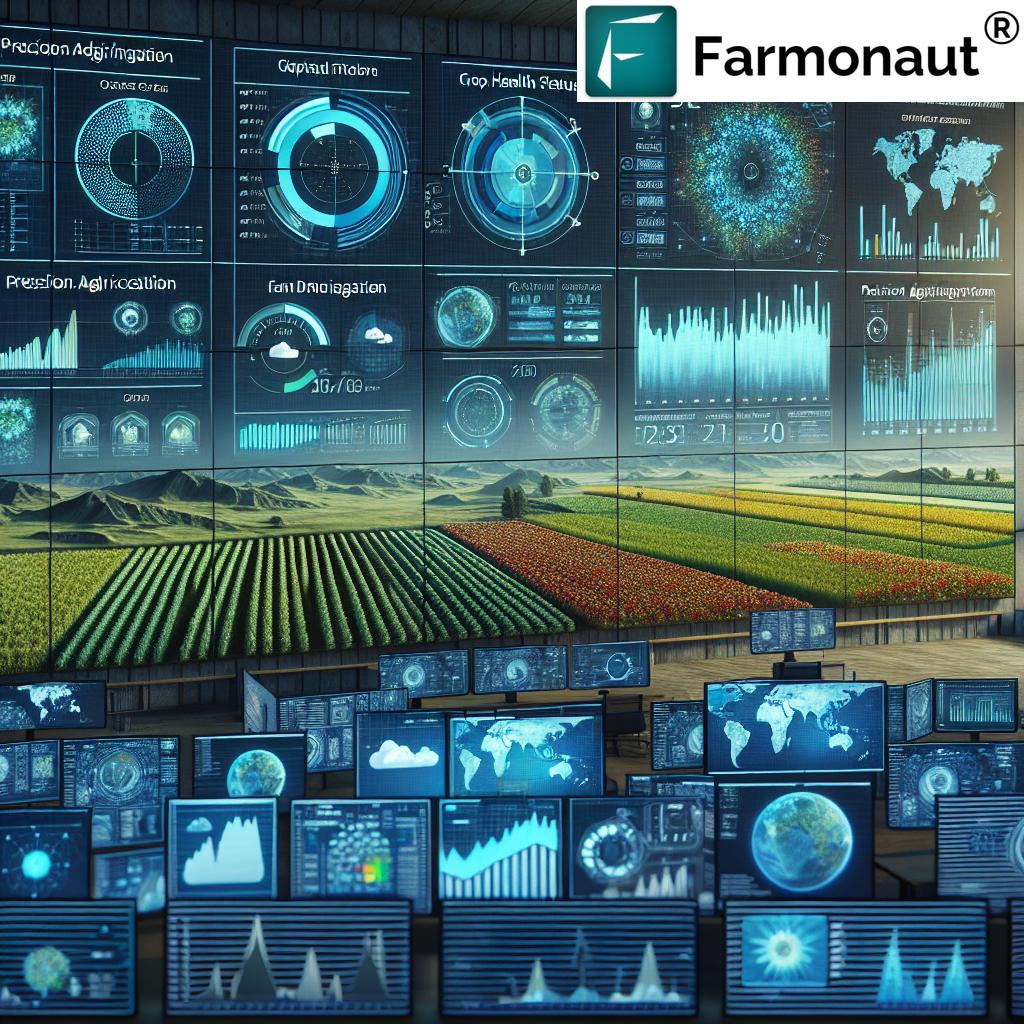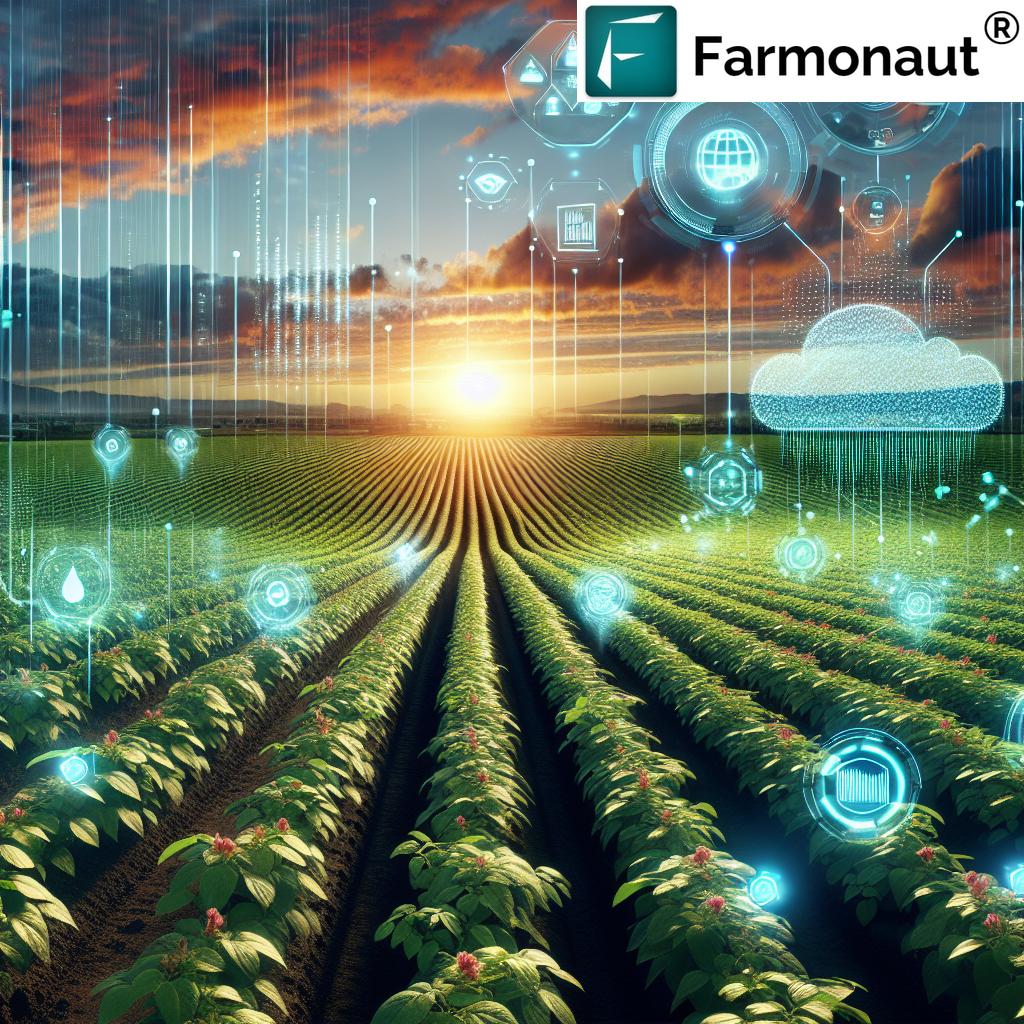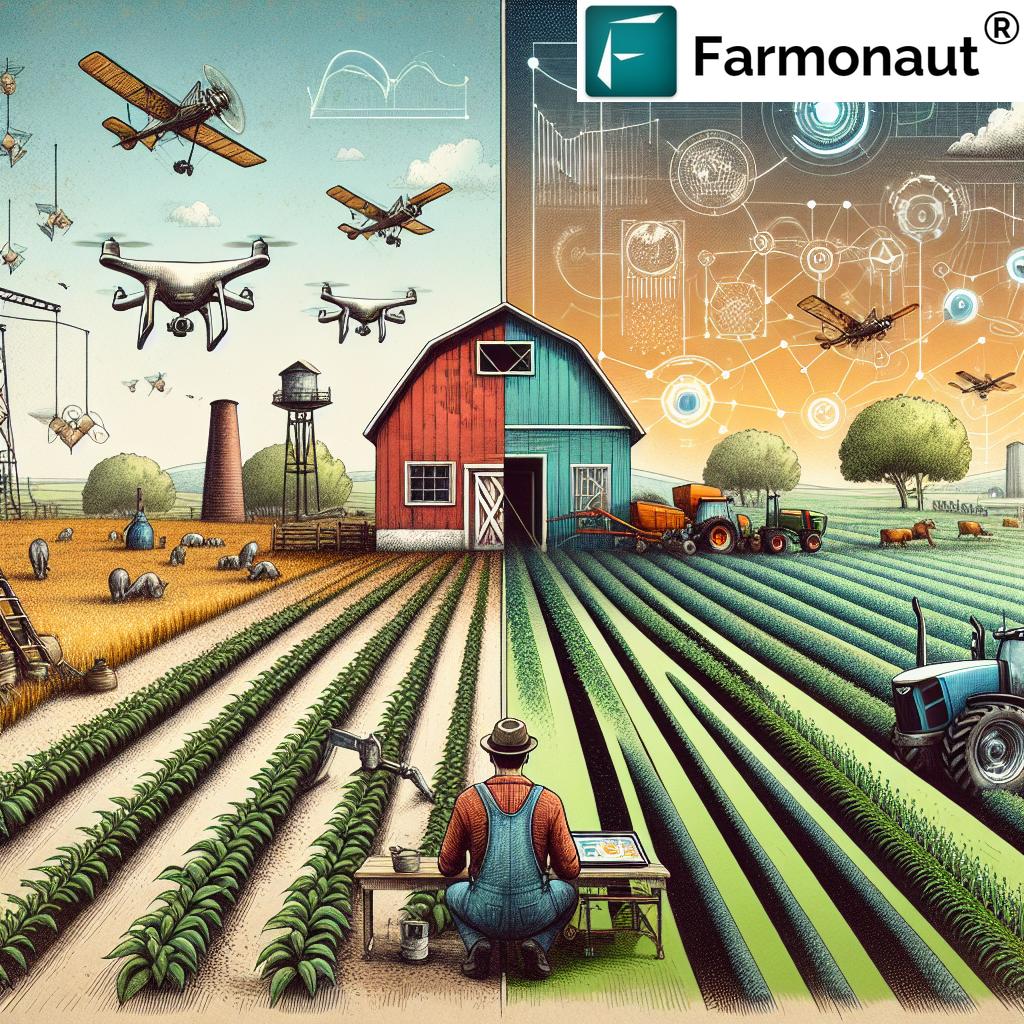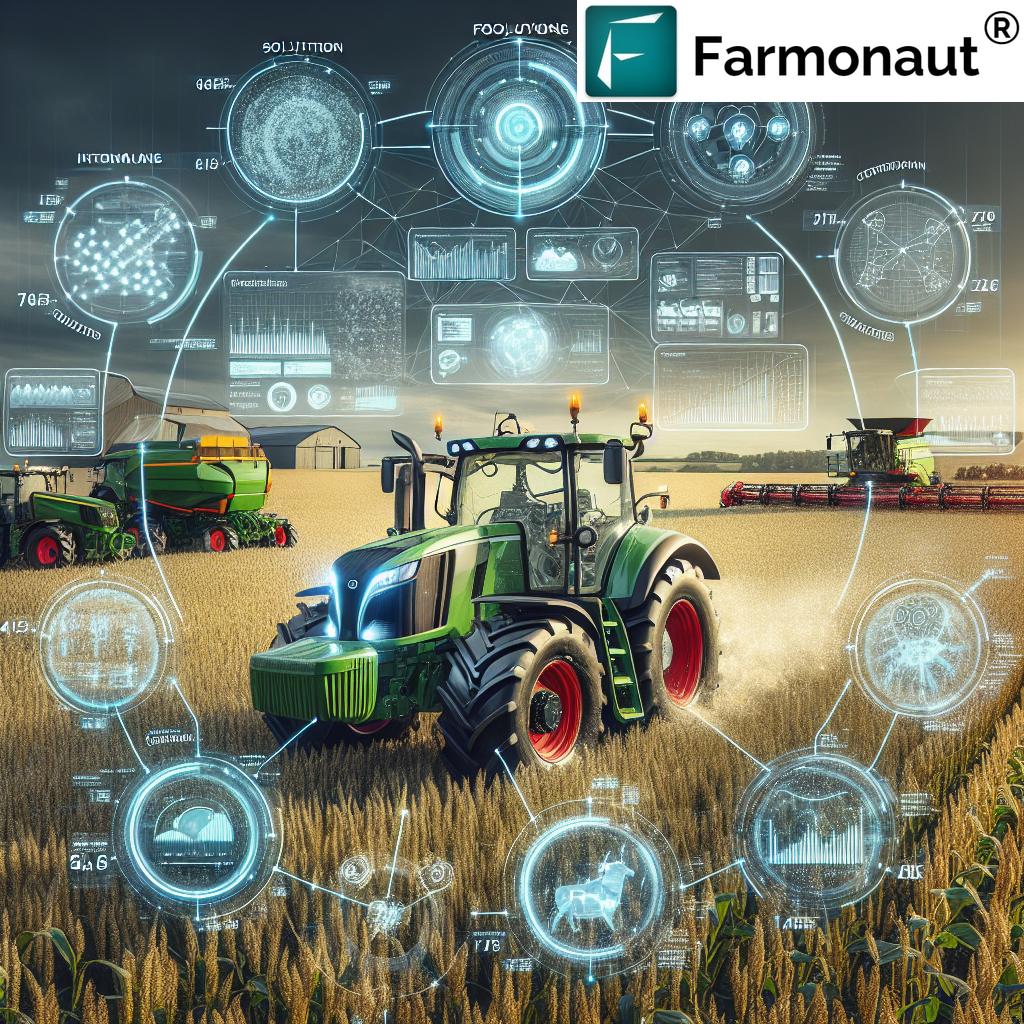Cow Heat Detection Systems, Crop & AI Pest Detection: Advancements Revolutionizing Agriculture in 2025
“AI pest detection in 2025 will analyze up to 1 million crop images daily for rapid threat identification.”
Table of Contents
- Introduction: The Technological Revolution in Agriculture
- Cow Heat Detection Systems: AI-Powered Precision for Livestock Management
- AI Pest Detection in Agriculture: Early & Accurate Insights for Sustainable Farming
- Crop Detection: Smarter, Data-Driven Decision-Making
- Comparative Features Table: Traditional vs. AI Solutions
- Farmonaut’s Role in Smart Agriculture: AI, Satellites & Blockchain
- Integrating AI Detection Systems for the Future Farm
- Farmonaut’s Subscription Solutions
- Frequently Asked Questions
- Conclusion: 2025 and Beyond
Introduction: The Technological Revolution in Agriculture
Agriculture stands at the cusp of a technological revolution in 2025, driven primarily by artificial intelligence (AI), machine learning, and smart detection systems. The rapid evolution of cow heat detection systems, crop detection, and AI pest detection agriculture is revolutionizing farming practices, helping farmers achieve unparalleled efficiency, sustainability, and food security.
Farmers, researchers, and agribusinesses are swiftly embracing intelligent solutions that analyze real-time data from fields and livestock, reducing labor, increasing accuracy, and proactively addressing threats before they escalate.
With growing climate unpredictability, population expansion, and pressing resource constraints, advanced detection, and management systems are essential in improving yields, reducing chemical usage, and supporting environmental sustainability across all regions, especially developing ones.
Instantly monitor your land, crops, or livestock via AI and satellite insights: Try the Farmonaut Web & Mobile Apps or access our robust API and Developer Docs for seamless integration!
Cow Heat Detection Systems: AI-Powered Precision for Livestock Management
Introduction to Automated Heat Detection
Cow heat detection systems utilize AI, advanced sensor technology, and machine learning algorithms to revolutionize livestock management. Timely and accurate detection of estrus (heat) in cows is critical for effective breeding, optimal dairy production, and the overall health of livestock herds.
Historically, farmers have relied upon visual observation and manual record-keeping to track cow reproductive cycles. This traditional method is laborious, prone to error, and often ineffective—especially as herd sizes increase or when farmers are managing multiple sites. Missed heats result in lost breeding opportunities, lower conception rates, and significant economic losses.
“Smart cow heat detection systems can improve breeding accuracy by over 80% compared to traditional observation.”
Modern AI Heat Detection: Components & Capabilities
- Wearable Sensors: Collars, pedometers, and tags detect changes in movement, rumination, and physiological signals associated with heat.
- AI and Data Analytics: Machine learning models process sensor data to identify patterns—recognizing the subtle onset of estrus earlier and with greater accuracy than traditional observation.
- Automated Alerts: Mobile apps or integrated farm management systems notify farmers in real-time, enabling timely breeding decisions and reducing missed opportunities.
- Integration with Smart Farm Platforms: Modern heat detection can be linked to broader precision agriculture systems, analytics for animal health, and operational scheduling.
Benefits of AI Cow Heat Detection Systems
- Accuracy: Achieve over 80% improved breeding detection rates, reducing failed inseminations and repeat service costs.
- Time Savings: Automate daily observation efforts, freeing up farmers for higher-value tasks.
- Animal Welfare: Reduce animal stress with less invasive monitoring and timelier interventions.
- Sustainability: Higher conception rates mean reduced resource usage per calf or liter of milk.
- Data-Driven Herd Management: Historical and real-time analytics set new benchmarks in breed improvement and overall livestock health, a critical factor as global population grows and food security becomes more pressing.
How Detection Works in 2025: Real-World Example
In 2025, modern heat detection systems process thousands of animal motion and health data points per day—classifying early behavioral cues far beyond human perception. When a cow displays activity or physiological signs suggestive of estrus, the system automatically sends a smartphone or dashboard alert, recommends the optimal breeding window, and even tracks reproductive management metrics over time.
With these AI-driven tools, farmers can increase productivity, reduce missed cycles, and improve the overall sustainability of livestock operations.
AI Pest Detection in Agriculture: Early & Accurate Insights for Sustainable Farming
The Challenge of Pest Management in Modern Agriculture
Pest infestations remain a leading cause of crop losses worldwide, costing billions annually and threatening livelihoods—especially in developing regions. Traditional pest detection—mainly visual crop scouting—has significant limitations: it’s labor-intensive, reactive, inefficient, and fails to detect early and subtle infestations.
The genetic diversity among pests, their ever-evolving nature, and climate-driven shifts mean that farmers struggle to manage pests effectively, often overusing pesticides and causing environmental harm.
AI-Powered Pest Detection Systems: How Technology Is Revolutionizing the Field
- High-Resolution Cameras & Drones: Vital for capturing a continuous stream of field imagery—identifying early presence, patterns, and severity of pest infestations.
- Satellite-Based Monitoring: Multispectral images detect subtle changes in crop health (NDVI, chlorophyll levels) and can infer pest or disease stress long before it’s visible to the naked eye.
- Ground Sensors & IoT Devices: Soil moisture, air quality, and microclimate sensors supply real-time environmental data used to model pest population surges.
- AI & Machine Learning Algorithms: Rapidly process millions of images and datasets, learning to recognize the distinguishing features of pest species, developmental stages, and crop-specific damage.
- Predictive Analytics: Leveraging big data and historical patterns to forecast pest emergence, hotspots, and recommend optimal intervention strategies.
AI Pest Detection Agriculture: Key Benefits
- Early Warning: Catch infestations in their initial stages to reduce severity and limit the scope of crop damage.
- Targeted Intervention: Map pest hotspots; apply pesticides, biocontrol agents, or other treatments only where needed in optimal quantities, drastically reducing chemical usage (Explore Farmonaut’s carbon footprinting for environmental monitoring).
- Resource Efficiency: Minimize chemical impact, decreasing overall input costs and environmental harm.
- Reduced Pest Resistance: Decrease the risk of pests developing resistance due to over-application of harmful chemicals.
- Improved Food Security & Sustainability: By reducing losses, supporting yields, and making farming more resilient to changing climate and population demands.
Want to harness AI-powered pest detection, crop detection, and sustainability tools for your farm? Discover Farmonaut’s Agro Admin platform for large-scale farm management.
From Early Detection to Proactive Management
- Farmers receive real-time alerts to smartphones or web dashboards, pinpointing the severity, type, and location of infestations.
- AI tools suggest targeted treatments and update predictive forecasts as new data is captured.
- AI systems continuously “learn” from new infestations, adapting to evolving pest behavior and climatic changes.
In 2025, AI pest detection agriculture is not just about eliminating threats, but integrating smart management for truly sustainable, efficient, and profitable farming.
Reducing Chemical Usage & Optimizing Inputs
Precision detection means farmers no longer blindly blanket fields with pesticides. Instead, they use the minimum necessary intervention—preserving beneficial insects and supporting environmental sustainability.
Ready to optimize spraying and pest management? Try Farmonaut for real-time field status, pest, and crop advisories.
Crop Detection: Smarter, Data-Driven Decision-Making
What Is Crop Detection?
Crop detection refers to the automatic identification, classification, and health monitoring of crops across vast agricultural fields using satellite imagery, AI, and sensors. This technology allows farmers and agribusinesses to:
- Track what is being grown, where, and in what quantity.
- Assess crop vigor and early-stage problems.
- Optimize planning, harvest scheduling, and logistics for maximum efficiency and yield improvement.
How AI-Powered Crop Detection Works
- Remote Sensing & Multispectral Satellite Imagery: Detect subtle variations in crop type, growth stages, and health using reflected light signatures.
- Machine Learning Models: Trained on massive datasets to recognize patterns of crop structure, spacing, and vigor.
- Integration with Environmental Sensors: Combine soil, moisture, and microclimate data for comprehensive analysis of crop performance.
- Mobile & Web Applications: Deliver real-time actionable insights directly to the hands of farmers and managers.
Farmonaut’s AI models automatically analyze field boundaries, crop type, stress levels, and expected yield using time-series satellite data. This empowers farmers, businesses, and governments to make proactive decisions about irrigation, fertilizers, and harvest logistics.
Advantages Over Traditional Crop Monitoring
- Scale: Monitor thousands of hectares in seconds—impossible with manual field scouting.
- Accuracy: Reduce subjectivity; get an objective, repeatable dataset
- Early Action: Detect deficiencies, disease, or suboptimal conditions early and intervene before yields decline.
- Transparency: Enable accurate reporting for compliance, insurance, and traceability (Discover blockchain-powered traceability for crops).
Farmonaut’s AI-Driven Crop Identification
At Farmonaut, we utilize the latest in satellite and AI technologies to provide:
- Automated crop classification and zoning for farms of any size.
- Field-level health analysis, pest/disease risk mapping, and yield forecasting
- API integration for large businesses or government agri-programs (Learn more about Farmonaut’s satellite+AI APIs).
Empower your agri-enterprise with scalable data—from a backyard field to regional lands.
Comparative Features Table: Traditional vs. AI-Driven Detection Systems
| Area of Application | Traditional Method | AI Solution | Estimated Accuracy Improvement | Estimated Time Savings | Sustainability Impact |
|---|---|---|---|---|---|
| Cow Heat Detection | Visual observation, breeding charts, manual notes | Wearable sensors, AI pattern detection, automated alert systems | +80% | >90% less time (from hours/week to minutes/day) | Higher conception rates, reduced resources/animal, optimized herd health |
| Crop Detection | Manual field scouting, basic surveys, farmer-reported data | Satellite imagery, AI image recognition, integrated sensors | +70% | >95% less time (minutes vs. weeks for surveys) | Less wastage, early interventions reduce chemical use, improved reporting |
| Pest Detection | Manual scouting, trap counting, periodic visual inspection | AI-powered drones, cameras, satellites, algorithm-driven alerts | +85% | >90% less labor and faster detection | Drastically reduced pesticide/chemical application, preserves local ecology |
Key Takeaways from the Table:
- AI solutions deliver accuracy and time savings of over 70–85% compared to manual, traditional methods.
- Sustainability impact is profound, with drastic reductions in chemical use, labor requirements, and better resource allocation for food production and animal health.
- The transition to AI-powered detection systems leads to more precise, data-driven management—vital for scaling food security and environmental protection in 2025 and beyond.
Farmonaut’s Role in Smart Agriculture: AI, Satellites & Blockchain
At Farmonaut, we are committed to democratizing AI, satellite imaging, and data-driven analysis for every farmer, business, and government. Our platform supports:
- Satellite-based monitoring: Multispectral imaging for NDVI crop health, heat/drought stress, and pest/disease prediction.
- AI-powered advisory systems: Our proprietary Jeevn AI analyzes satellite data, local weather, and field conditions to recommend timely, optimal actions for pest, health, irrigation, and resource management.
- Blockchain traceability: Secure, verifiable supply chain transparency from seed to harvest (Explore product traceability features).
- Fleet and resource management: Integrate with GPS tracking and usage analytics for all on-farm vehicles and machinery, shrinking operational costs (Learn about Farmonaut’s fleet management tools).
- Environmental sustainability: Leverage carbon footprint tracking, pesticide input optimization, and rapid health/disease/event reporting for compliance, insurance and finance (See Farmonaut carbon footprint monitoring).
Our solutions scale from a single family farm to government-wide monitoring programs—making advanced AI pest detection agriculture, crop detection, and livestock health accessible everywhere.
Integrating AI Detection Systems for the Future Farm
The convergence of cow heat detection systems, crop detection systems, and AI pest detection agriculture technologies is creating the smart, resilient, and highly efficient farm of 2025.
- End-to-End Visibility: Farmers manage everything—from livestock ovulation to field-level crop health and pest outbreaks—in one digital ecosystem.
- Cross-functional Insights: Link animal, plant, soil, and weather data for holistic decision-making—increase yields, reduce resource waste, and improve environmental performance.
- Automated Compliance & Traceability: Blockchain and real-time data feed supply chain transparency, building consumer trust and opening new markets for sustainable produce.
- Instant API Integration: Use Farmonaut’s API for seamless deployment of detection and analytics—scale operations from field to country.
The Role of Apps, Cloud, and API Connectivity
- Mobile First: Farmers and agronomists receive real-time, AI-based advisories on-the-go (Try Farmonaut’s Web/Mobile Apps for live field insights).
- Cloud Dashboards: Large enterprises, organizations, and government users gain panoramic views covering regions or even entire countries.
- Automated Reporting: For compliance, insurance claims, and AI-powered crop loan and insurance verification (Explore Farmonaut’s digital loan/insurance solutions).
This digital ecosystem drastically increases efficiency, accuracy, and sustainability.
Farmonaut’s Subscription Solutions
Farmonaut’s cost-effective, modular subscription plans enable businesses, farmers, governments, and researchers to access advanced satellite monitoring, AI detection, resource management, and blockchain traceability without the need for specialized equipment.
Access Farmonaut from anywhere: Use our intuitive Web App, Android App, or iOS App.
Frequently Asked Questions
1. What are the main benefits of using AI pest detection agriculture systems?
AI pest detection systems deliver early, precise, and cost-effective identification of pests; they allow targeted interventions, reduce pesticide use, support food security, and provide real-time decision support for farmers.
2. How does AI improve cow heat detection?
AI-driven cow heat detection systems use sensor and behavioral data to detect estrus with over 80% more accuracy than traditional observation. Farmers benefit from timely alerts, improved conception rates, and enhanced animal welfare.
3. What data sources power crop and pest detection systems?
State-of-the-art crop and pest detection systems aggregate satellite imagery, drone images, IoT sensor data, historical yield and climate databases, and machine learning models trained on global agricultural patterns.
4. Are Farmonaut’s AI and satellite-based solutions suitable for smallholder farmers?
Yes! Farmonaut democratizes technology—offering affordable, easy-to-use platforms accessible via web or mobile app, with flexible pricing for any size of farm or operation.
5. Can I integrate Farmonaut’s insights with other farm management systems?
Absolutely. Farmonaut’s open API allows seamless integration of AI and satellite insights into existing farm management, ERP, or GIS platforms.
6. How do these technologies support environmental sustainability?
By reducing unnecessary chemical use, preserving biodiversity, and optimizing resource inputs, AI detection systems lower agriculture’s environmental footprint and help meet sustainable development goals.
Conclusion: Agriculture on the Cusp of a Smart, Sustainable Revolution
In 2025, agriculture is being fundamentally reshaped by AI-powered cow heat detection, crop detection, and pest detection systems. These advancements promote unprecedented accuracy, proactive decision-making, and efficient management of farms and livestock, ensuring a sustainable future as global food demand rises.
Farmers, agribusinesses, and governments globally are now equipped with the tools to:
- Detect and manage threats early, minimizing losses and optimizing yields.
- Reduce chemical usage, conserving the environment while protecting crops and animals.
- Utilize real-time, scalable insights for informed decisions across the supply chain.
- Integrate affordable, accessible technology into daily operational practices, removing barriers for developing regions.
The era of data-driven, sustainable, and smart agriculture is here—farmers, it’s time to embrace the revolution!
Ready to experience the future of farming?
- Monitor your crops, livestock, and pests in real-time—Get started with Farmonaut’s web & mobile apps.
- Integrate advanced detection and analytics into your agri-business—Try our powerful APIs.
- Enhance your environmental, sustainability, and resource stewardship programs—Explore carbon footprinting and traceability tools by Farmonaut.












